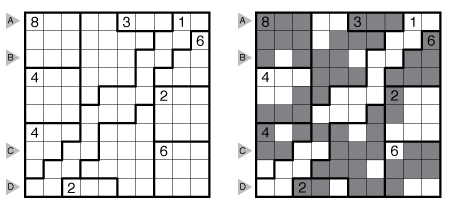Aqre Rules and Info
Aqre has been featured as a “Better Know a Puzzle” video which will give even more info than what is below, including our thoughts on why the puzzle is special.

Rules: Shade some cells so that all shaded cells form one connected group. Regions with numbers must contain the indicated count of shaded cells, and it is allowed to shade over the numbered cells. There may not exist a run of four or more consecutive shaded or unshaded cells horizontally or vertically anywhere in the grid.
Answer String: Enter the length in cells of each of the shaded segments from left to right for the marked rows, starting at the top. Separate each row’s entry with a comma. This example has the key “33,132,232,23”.
(Brief) History of Aqre: Aqre was created in mid-to-late 2020 by Eric Fox and was first published on his blog in December 2020. It was inspired by other area shading puzzles as well as extra constraints like “no four in a row” with the novel aspect of applying that constraint to both shaded and unshaded cells. The name Aqre (pronounced “Ay-kur”) derives from the combination of the English word acre (a unit of land area) with the author’s favorite letter Q.
History of this example: This “Slash” Aqre was designed by Eric Fox for the first week of Aqre puzzles on Grandmaster Puzzles.
Sources for Aqre Puzzles: Follow this link for more Aqre puzzles on this website. If you are new to this puzzle type, here are our easiest Aqre Puzzles to get started on. More Aqre puzzles can be in the Shading Variety Collection by Prasanna Seshadri, as well as on Eric Fox’s blog.
Design rules for contributors: A Grandmaster Aqre will have a unique solution that can be reached by logic alone. Generally, a Grandmaster Aqre should have an interesting visual theme or an interesting solution; while no requirements of grid symmetry exist, symmetry is a common feature for these puzzles. Number clues should either be uniformly placed in the upper-left most cell of regions, or arranged in a symmetric/themed pattern. Sizes from 10×10 and above are recommended (maximum aspect ratio of 2:1 if rectangular).
